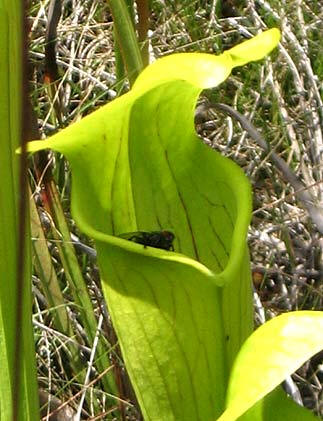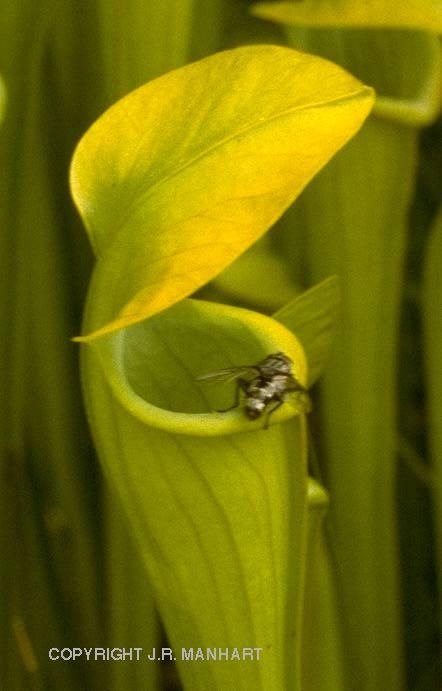|
|
|
|
|
 |
|
|
|
|
|
|
|
FLY! It's what's for Dinner! |
|
|
|
|
The pale pitcher plant acquires nutrients from
the soil along with undergoing photosynthesis in its trumpet shaped leaves.
These pitcher plants usually reside in habitats that don't have a very good supply of all the components that the plant
needs. So the plant needs to acquire these components elsewhere. The
Sarracenia
habitats that don't have a very good supply of all the components that the plant
needs. So the plant needs to acquire these components elsewhere. The
Sarracenia
 alata
like many other carnivorous plants acquires all of
its
required nutrients by feeding on insects such as bees, ants, and flies.
These insects become an important part of the pitcher plant's diet because they
are a key source of Nitrogen that they can't absorb from the soil.
alata
like many other carnivorous plants acquires all of
its
required nutrients by feeding on insects such as bees, ants, and flies.
These insects become an important part of the pitcher plant's diet because they
are a key source of Nitrogen that they can't absorb from the soil.
As far as whether or not the pale pitcher plant is heterotrophic or autotrophic is a matter of opinion. I personally think that the pitcher plant can be both. Studies have shown that a carnivorous plant such as this one can survive without feeding on insects. While they tend to be much smaller and produce less, they survive nonetheless (autotrophic). But studies have also shown that the pitcher plant as well as other carnivorous plants are benefiting from the consumption of these insects. They grow taller and produce more seeds (heterotrophic).
The Sarracenia alata also has a very
interesting way of gaining the attention of its prey. The plant secretes a
little of its nectar
 onto
the lid of the plant. Then the insect comes near to the plant and begins
to feed. The insect is fooled into thinking that this is just another
flowering plant with nectar. It continues to move down into the pitcher
plant to get more nectar until it reaches the "point of no return". The
insect is caught unable to climb out of the plant. The plants waxy surface
and downward pointing hairs keep the insect from crawling out.
onto
the lid of the plant. Then the insect comes near to the plant and begins
to feed. The insect is fooled into thinking that this is just another
flowering plant with nectar. It continues to move down into the pitcher
plant to get more nectar until it reaches the "point of no return". The
insect is caught unable to climb out of the plant. The plants waxy surface
and downward pointing hairs keep the insect from crawling out.
The number of insects caught by a pitcher plant varies. There are several important factors that need to be taken into consideration when counting the number of insects caught by a pitcher plant. Some of these factors are insect population, soil content, feeding rates, and competition among other carnivorous plants. One thing is for sure, the more insects consumed the better the plants growth and reproductive capabilities.
|
|
|
|
|
|
||